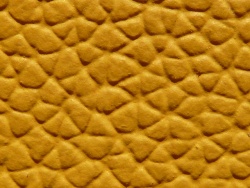Difference between revisions of "Full grain leather"
(Created page with "<p align=center> 300px </p> '''Vollnarbiges Leder''' ist Glattleder aus dem Narbenspalt, das nicht geschliffen wurde un...") |
|||
| (5 intermediate revisions by one user not shown) | |||
| Line 4: | Line 4: | ||
| − | + | Full grain leather is [[smooth leather]] from the [[Top grain leather|grain side]], which has not been [[Sanding leather|buffed (sanded)]] and where the [[Natural leather grain|natural grain pattern]], including the [[Natural markings on leather|skin irregularities]] of the animal, is still recognisable. [[Sanding leather|Sanding, buffing]] and similar work stages lead to a different term and cannot be declared as "full grain leather". [[Aniline leather]] and [[Semi-aniline|semi-aniline leather]] are [[smooth leather]] types, where the natural grain must remain in order to be classed as full grain leather. | |
| − | + | Full-grain leather is considered to be of [[leather quality|higher quality]], because the surface is more [[Haptic evaluation of leather surfaces|natural]] and the thickness of the [[finish|colour layer]] is usually less. | |
| − | + | [[Embossed leather]] is frequently [[Sanding leather|sanded]] before embossing. In order to smooth the surface again with a [[finish]], a thicker [[leather colour|colour layer]] is required than with the surface coloration of a full-grain leather. The thickness of the colour layer influences the softness and naturalness of a leather and therefore full-grain leather is more natural and feels nicer. | |
| − | + | ||
| − | + | ||
<p align=center> | <p align=center> | ||
| − | [[bild:Pigmentierung-Poren-004.jpg| | + | [[bild:Pigmentierung-Poren-004.jpg|500px]] |
| − | + | ||
| − | + | ||
</p> | </p> | ||
<p align=center> | <p align=center> | ||
| − | ''[[ | + | [[bild:Pigmentierung-Poren-002.jpg|250px]] |
| + | [[bild:Pigmentierung-Poren-001.jpg|250px]] | ||
| + | </p> | ||
| + | <p align=center> | ||
| + | ''[[Natural leather grain]]. The [[Leather hair pores - Hair follicles|hair pores]] are well visible -> Full leather grain.'' | ||
</p> | </p> | ||
<p align=center> | <p align=center> | ||
| − | [[bild:Pigmentierung-gepraegt-003.jpg| | + | [[bild:Pigmentierung-gepraegt-003.jpg|500px]] |
| − | + | ||
| − | + | ||
</p> | </p> | ||
<p align=center> | <p align=center> | ||
| − | + | [[bild:Pigmentierung-gepraegt-002.jpg|250px]] | |
| + | [[bild:Pigmentierung-gepraegt-001.jpg|250px]] | ||
| + | </p> | ||
| + | <p align=center> | ||
| + | ''[[Corrected grain]]. The [[Leather hair pores - Hair follicles|hair pores]] are completely [[finish|covered]] and [[Sanding leather|removed]] -> Not "full leather grain".'' | ||
</p> | </p> | ||
| − | + | There are also leathers, where a pattern is [[embossed leather|embossed]] in a full grain leather. Provided that the [[Natural leather grain|naturalness of the grain]] remains intact, it can still be called "full grain leather". | |
<p align=center> | <p align=center> | ||
| − | + | [[bild:Autoleder-Praegung-ungescchliffen-BMW-Picasso-002.jpg|500px]] | |
| − | + | ||
| − | [[bild:Autoleder-Praegung-ungescchliffen-BMW-Picasso-002.jpg| | + | |
</p> | </p> | ||
<p align=center> | <p align=center> | ||
| − | ''[[ | + | [[bild:Moebelleder-Praegung-ungesschliffen-0022.jpg|250px]] |
| + | [[bild:Autoleder-Praegung-ungesch2.jpg|250px]] | ||
| + | </p> | ||
| + | <p align=center> | ||
| + | ''[[Embossed leather#Embossed leather without sanding|Embossed]], but not [[Sanding leather|buffed (sanded)]] leather. The [[Leather hair pores - Hair follicles|hair pores]] are well visible -> Also "full leather grain".''<br></p> | ||
<p> </p> | <p> </p> | ||
| − | |||
| − | |||
| − | |||
== Additional information == | == Additional information == | ||
| − | * [[ | + | * [[Full leather trim]] |
| − | * [[ | + | * [[Leather grain - Grain side]] |
| − | * [[ | + | * [[Top grain leather]] |
| − | * [[ | + | * [[Natural leather grain]] |
| + | * [[Leather hair pores - Hair follicles]] | ||
| − | < | + | <logoplustext /> |
| − | + | ||
| − | + | ||
| − | + | ||
| − | + | ||
| − | + | ||
Latest revision as of 17:01, 19 September 2022
Full grain leather is smooth leather from the grain side, which has not been buffed (sanded) and where the natural grain pattern, including the skin irregularities of the animal, is still recognisable. Sanding, buffing and similar work stages lead to a different term and cannot be declared as "full grain leather". Aniline leather and semi-aniline leather are smooth leather types, where the natural grain must remain in order to be classed as full grain leather.
Full-grain leather is considered to be of higher quality, because the surface is more natural and the thickness of the colour layer is usually less.
Embossed leather is frequently sanded before embossing. In order to smooth the surface again with a finish, a thicker colour layer is required than with the surface coloration of a full-grain leather. The thickness of the colour layer influences the softness and naturalness of a leather and therefore full-grain leather is more natural and feels nicer.
Natural leather grain. The hair pores are well visible -> Full leather grain.
Corrected grain. The hair pores are completely covered and removed -> Not "full leather grain".
There are also leathers, where a pattern is embossed in a full grain leather. Provided that the naturalness of the grain remains intact, it can still be called "full grain leather".
Embossed, but not buffed (sanded) leather. The hair pores are well visible -> Also "full leather grain".
Additional information
- Full leather trim
- Leather grain - Grain side
- Top grain leather
- Natural leather grain
- Leather hair pores - Hair follicles

















 a kotori web solution
a kotori web solution